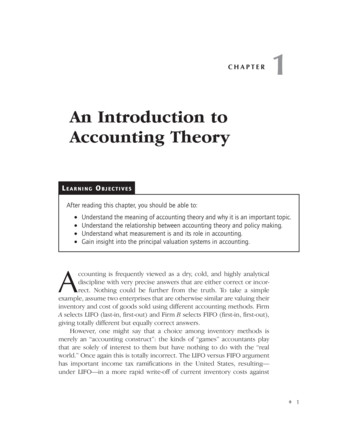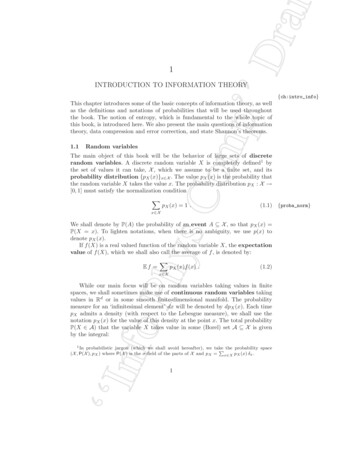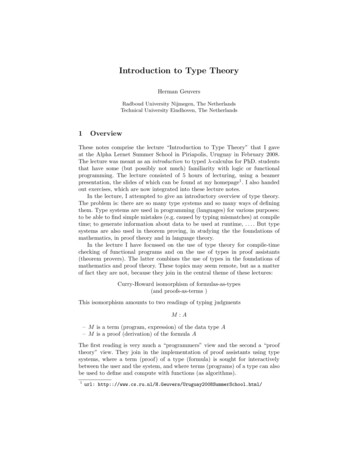
Transcription
CHAPTER1An Introduction toAccounting TheoryLearning ObjectivesAfter reading this chapter, you should be able to: Understand the meaning of accounting theory and why it is an important topic.Understand the relationship between accounting theory and policy making.Understand what measurement is and its role in accounting.Gain insight into the principal valuation systems in accounting.Accounting is frequently viewed as a dry, cold, and highly analyticaldiscipline with very precise answers that are either correct or incorrect. Nothing could be further from the truth. To take a simpleexample, assume two enterprises that are otherwise similar are valuing theirinventory and cost of goods sold using different accounting methods. FirmA selects LIFO (last-in, first-out) and Firm B selects FIFO (first-in, first-out),giving totally different but equally correct answers.However, one might say that a choice among inventory methods ismerely an “accounting construct”: the kinds of “games” accountants playthat are solely of interest to them but have nothing to do with the “realworld.” Once again this is totally incorrect. The LIFO versus FIFO argumenthas important income tax ramifications in the United States, resulting—under LIFO—in a more rapid write-off of current inventory costs against –1
2– – ACCOUNTING THEORYrevenues (assuming rising inventory prices), which generally means lowerincome taxes. Thus an accounting construct has an important “social reality”: how much income tax is paid.1Income tax payments are not the only social reality that accountingnumbers affect. Here are some other examples:1. Income numbers can be instrumental in evaluating the performanceof management, which can affect salaries and bonuses and evenwhether individual management members retain their jobs.2. Income numbers and various balance sheet ratios can affect dividendpayments.3. Income numbers and balance sheet ratios can affect the firm’s creditstanding and, therefore, the cost of capital.4. Different income numbers might affect the price of the firm’s stockif the stock is publicly traded and the market cannot “see through”the accounting methods that have been used.Since accounting numbers can have important social consequences,why is it that we cannot always measure “economic reality” accurately?Different perceptions exist of economic reality. For example, on the onehand, we may say that the value of an asset is equal to the amount paid forit in markets in which the asset is ordinarily acquired, or, on the other hand,some may see an asset’s value represented by the amount the firm canacquire by selling the asset. These two values are not the same. The formervalue is called replacement cost or entry value, and the latter is called exitvalue (these are not the only possible value choices). Both values are discussed in the appendix to this chapter and in Chapter 14. Exit values are usually lower than entry values because the owning enterprise does not generallyhave the same access to buyers as firms that regularly sell the asset throughordinary channels. Hence, there is a valuation choice between exit and entryvalues. Suppose, however, that we take the position that both of these valuations have merit but they are not easy to measure because market quotationsare not available and users may not understand what these valuations mean.Hence, a third choice may arise: historical cost. While entry and exit valuesrepresent some form of economic reality, the unreliability of the measurements may lead some people to opt for historical cost on the grounds thatusers understand it better than the other two approaches and measurementof the historical cost number may be more reliable.The question we have just been examining, the choice among accounting values, including historical cost, falls within the realm of accounting
An Introduction to Accounting Theory– –3theory. There are, however, other issues that arise in this example, bothimplicit and explicit:1. For what purposes do users need the numbers (e.g., evaluating management’s performance, evaluating various aspects of the firm’scredit standing, or even using the accounting numbers as an inputfor predicting how well the enterprise will do in the future)?22. How costly will it be to generate the desired measurement?The choice among the different types of values, as well as the relatedissues, falls within the domain of accounting theory. The term accountingtheory is actually quite mysterious. There are many definitions throughoutthe accounting literature of this somewhat elusive term. Accounting theoryis defined here as the basic assumptions, definitions, principles, and concepts—and how we derive them—that underlie accounting rule making bya legislative body. Accounting theory also includes the reporting of accounting and financial information. There has been and will continue to be extensive discussion and argumentation as to what these basic assumptions,definitions, principles, and concepts should be; thus, accounting theory isnever a final and finished product. Dialogue always continues, particularly asnew issues and problems arise. As the term is used here, it applies to financial accounting and not to managerial or governmental accounting.Financial accounting refers to accounting information that is used byinvestors, creditors, and other outside parties for analyzing managementperformance and decision-making purposes.3We interpret the definition of accounting theory broadly. Clearly, thedrafting of a conceptual framework that is supposed to provide underlyingguidance for the making of accounting rules falls within the coverage ofaccounting theory. Analyzing accounting rules to see how they conform toa conceptual framework or other guiding principles likewise falls within theaccounting theory realm. While the actual practice of accounting is generallyof less theoretical interest, questions such as why firms choose particularmethods when choice exists (the LIFO versus FIFO question, for example)are of theoretical interest because we want to know the reasons underlyingthe choice. In a pragmatic sense, one can say that accounting theory is concerned with improving financial accounting and statement presentation,although, because their interests are not exactly the same, conflict may existbetween managers and investors, and among other groups, relative to theissue of what improves financial stateme.We can also examine the types of topics, issues, and approaches discussed as part of accounting theory. In addition to conceptual frameworks
4– – ACCOUNTING THEORYand accounting legislation, accounting theory includes concepts (e.g., realization and objectivity), valuation approaches (discussed in Appendix 1-A),and hypotheses and theories. Hypotheses and theories are based on a moreformalized method of investigation and analysis of subject matter used inacademic disciplines such as economics and other social sciences employing research methods from philosophy, mathematics, and statistics. Thisnewer and more formal approach to the development of accounting theoryis a relatively recent innovation in our field and permeates much of the current accounting research. Researchers are attempting to analyze accountingdata to explain or predict phenomena related to accounting, such as howusers employ accounting information or how preparers choose amongaccounting methods.4Formalized analyses and investigation of accounting data are discussedin Chapter 2. The results of the research process are published in books andjournals (academic and professional) devoted to advancing knowledge offinancial accounting as well as other branches of accounting, such as costand management accounting, auditing, taxes, and systems. Various facets ofaccounting theory are discussed throughout this book.We begin by briefly examining the relationship between accountingtheory and the institutional structure of accounting. One of the objectivesof this book is to assess the influence of accounting theory on the rulemaking process. Hence, the approach adopted here is concerned with thelinkages (and often the lack thereof) between accounting theory and theinstitutions charged with promulgating the rules intended to improveaccounting practice. Closely related to accounting theory is the process ofmeasurement. Measurement is the assignment of numbers to properties orcharacteristics of objects. Measurement and how it applies to accounting areintroduced in this chapter and appear throughout the text. The appendix tothe chapter briefly illustrates the principal valuation approaches to accounting. These valuation methods are concerned with the measurement of economic phenomena. They are discussed in more depth in Chapter 14, butthey are also referred to in the intervening chapters on accounting theory.Accounting Theory and Policy MakingThe relationship between accounting theory and the standard-setting process must be understood within its wider context, as shown in Exhibit 1.1.We caution that Exhibit 1.1 is extremely simplistic. Economic conditionshave an impact on both political factors and accounting theory. Political factors, in turn, also have an effect on accounting theory. For example, after the
An Introduction to Accounting Theory– –5Statement of Financial Accounting Standards (SFAS) No. 96 on income taxallocation appeared in 1987, several journal articles as well as corporatepreparers of financial statements severely criticized it. Eventually, politicalfactors (see the following discussion regarding the costliness and difficultyof implementing SFAS No. 96) led to its replacement by SFAS No. 109.Despite its simplicity, Exhibit 1.1 is a good starting point for bringing outhow ideas and conditions eventually coalesce into policy-making decisionsthat shape financial reporting.Bodies such as the Financial Accounting Standards Board (FASB) andthe Securities and Exchange Commission (SEC), which are charged withmaking financial accounting rules, perform a policy function. This policyfunction is also called standard setting or rule making and specificallyrefers to the process of arriving at the pronouncements issued by the FASB,the SEC, or the International Accounting Standards Board (IASB). The inputsto the policy-making function come from three main (although not necessarily equal) sources: economic factors, political factors, and accounting theory.Exhibit 1.1 The Financial Accounting cConditionsAccountingPolicy MakingAccountingPracticeMain flowSecondary flowUsersof AccountingData and ReportsAudit Function:Compliance ofpractice withaccounting rules(control function)
6– – ACCOUNTING THEORYThe best example of an economic factor is the steep inflation of the 1970sin the United States, which was undoubtedly the catalyst that led the FASB toforce the disclosure of information concerning price changes, and is a classicexample of an economic condition that impinged on policy making. Anotherexample of an economic factor is the acceleration of mergers and acquisitions.The term political factors refers to the effect on policy making of thosewho are subject to the resulting rules or regulations. Included in this category are auditors, who are responsible for assessing whether the rules havebeen followed; preparers of financial statements, represented by organizations such as Financial Executives International (FEI); and investors, represented by organizations such as the CFA Institute and the public itself, whomight be represented by governmental groups such as Congress, or bydepartments or agencies of the executive branch of government, such as theSecurities and Exchange Commission (SEC).5In addition, the management of major firms and industry trade associationsare important political components of the policy-making process. Although ithas been important to give voice to those who are affected by accounting rulemaking, it should be remembered that political factors can subvert the standardsetting process. One example of this is the special purpose entity (SPE). SPEs,as the name implies, are arrangements whereby the firm and an outside equityinvestor jointly own an entity that basically may be a shell enterprise. SPEs allowfirms to “park” liabilities on the SPE’s balance sheet if the outside equity investorowns as little as 3% of the SPE. Leaving the liability off its own balance sheetimproves the firm’s debt–equity ratio and, in general, gives the firm’s balancesheet what we might call a “facelift.” The FASB’s initial attempt to solve the SPEproblem failed because of political interference by the then Big Five publicaccounting firms. However, due to public pressure resulting from the Enrondebacle, the FASB began to readdress this problem (see Chapter 18).Accounting theory is developed and refined by the process of accounting research. Accounting professors are the primary producers of accounting research, but many individuals from policy-making organizations, publicaccounting firms, and private industry also play an important role in theresearch process.Standards and other pronouncements of policy-making organizationsare interpreted and put into practice at the organizational level. Hence, theoutput of the policy level is implemented at the accounting practice level.Of course we have now entered an era when failures of large publicly tradedcompanies (e.g., Enron, WorldCom, Lehman Brothers Holdings) are goingto have a significant impact on financial accounting standards, auditingrules, and institutional structures of organizations such as the FASB and theSEC.6 Many of these issues are discussed in Chapters 3, 12, and 17.
An Introduction to Accounting Theory– –7Users consist of many groups and include actual and potential shareholders and creditors as well as the public at large. It is important to remember that users not only employ financial statements and reporting in makingdecisions,
of theoretical interest because we want to know the reasons underlying the choice. In a pragmatic sense, one can say that accounting theory is con- cerned with improving financial accounting and statement presentation, although, because their interests are not exactly the same, conflict may exist between managers and investors, and among other groups, relative to the issue of what improves .











